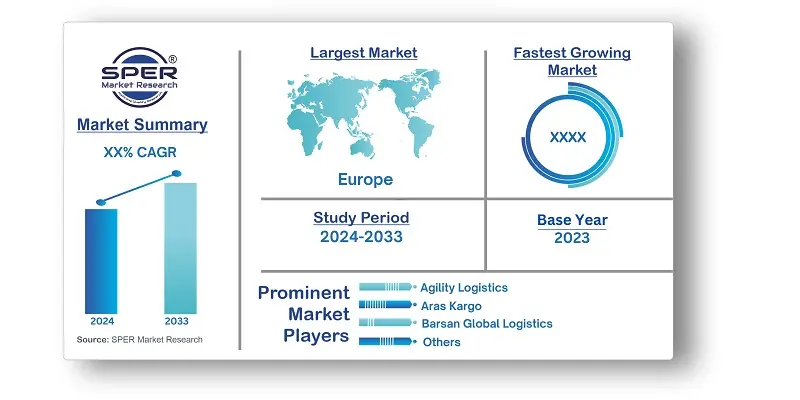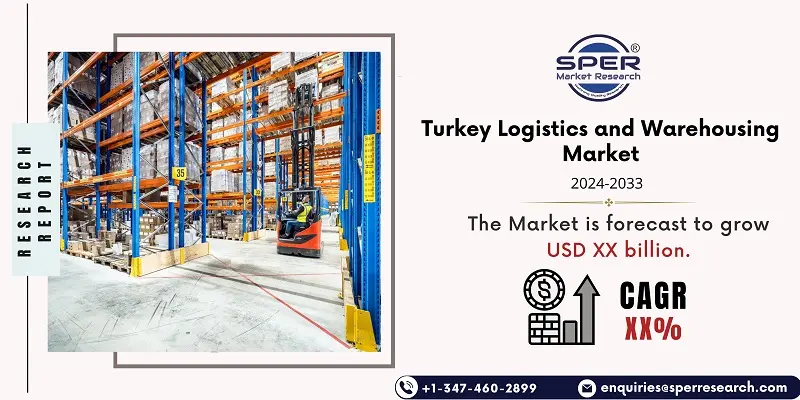
Turkey Logistics and Warehousing Market Growth, Size, Trends, Share, Revenue and Future Outlook
Turkey Logistics and Warehousing Market Size- By Mode of Service, By Mode of Freight, By Business Model, By Type of Warehouses, By End User- Regional Outlook, Competitive Strategies and Segment Forecast to 2033
| Published: Mar-2024 | Report ID: AMIN24104 | Pages: 1 - 103 | Formats*: |
| Category : Automotive & Transportation | |||


| Report Metric | Details |
| Market size available for years | 2020-2033 |
| Base year considered | 2023 |
| Forecast period | 2024-2033 |
| Segments covered | By Mode of Service, By Mode of Freight, By Business Model, By Type of Warehouses, By End User |
| Regions covered | North, South, East, West |
| Companies Covered | Agility Logistics, Aras Kargo, Barsan Global Logistics, Borusan Logistics, DB Schenker, DHL, Ekol Logistics, Hellmann Worldwide Logistics, Karinca Logistics, KITA Logistics, Kuehne + Nagel, Mars Logistics, MNG Kargo, Netlog Logistics, Omsan Logistics, Surat Kargo, Yurtici Cargo, Yusen Inci Logistics, Others |
- Logistics Companies
- Warehousing Companies
- Cold Chain Companies
- Courier and Parcel Companies
- Express Logistics Companies
- E-Commerce Logistics Companies
- Logistics Association
- Government Association
- Investors and Private Equity Companies
- Others
| By Mode of Service: |
|
| By Mode of Freight: |
|
| By Business Model: |
|
| By Type of Warehouses: |
|
| By End User: |
|
- Turkey Logistics and Warehousing Market Size (FY’2024-FY’2033)
- Overview of Turkey Logistics and Warehousing Market
- Segmentation of Turkey Logistics and Warehousing Market By Mode of Service (Air Freight, Rail Freight, Road Freight and via Pipelines, Sea Freight)
- Segmentation of Turkey Logistics and Warehousing Market By Mode of Freight (Domestic Freight Forwarding, International Freight Forwarding)
- Segmentation of Turkey Logistics and Warehousing Market By Business Model (Cold Storage, Container Freight/Inland Container Depot, Industrial/Retail)
- Segmentation of Turkey Logistics and Warehousing Market By Type of Warehouses (Closed Warehouses, Cold Storage, Open Yards)
- Segmentation of Turkey Logistics and Warehousing Market By End User (Automotive, Consumer Retail, Food and Beverages, Manufacturing, Others)
- Statistical Snap of Turkey Logistics and Warehousing Market
- Expansion Analysis of Turkey Logistics and Warehousing Market
- Problems and Obstacles in Turkey Logistics and Warehousing Market
- Competitive Landscape in the Turkey Logistics and Warehousing Market
- Impact of COVID-19 and Demonetization on Turkey Logistics and Warehousing Market
- Details on Current Investment in Turkey Logistics and Warehousing Market
- Competitive Analysis of Turkey Logistics and Warehousing Market
- Prominent Players in the Turkey Logistics and Warehousing Market
- SWOT Analysis of Turkey Logistics and Warehousing Market
- Turkey Logistics and Warehousing Market Future Outlook and Projections (FY’2024-FY’2033)
- Recommendations from Analyst
1.1.Scope of the report1.2.Market segment analysis
2.1.Research data source2.1.1.Secondary Data2.1.2.Primary Data2.1.3.SPER’s internal database2.1.4.Premium insight from KOL’s2.2.Market size estimation2.2.1.Top-down and Bottom-up approach2.3.Data triangulation
4.1.Driver, Restraint, Opportunity and Challenges analysis4.1.1.Drivers4.1.2.Restraints4.1.3.Opportunities4.1.4.Challenges4.2.COVID-19 Impacts of the Turkey Logistics and Warehousing Market
5.1.SWOT Analysis5.1.1.Strengths5.1.2.Weaknesses5.1.3.Opportunities5.1.4.Threats5.2.PESTEL Analysis5.2.1.Political Landscape5.2.2.Economic Landscape5.2.3.Social Landscape5.2.4.Technological Landscape5.2.5.Environmental Landscape5.2.6.Legal Landscape5.3.PORTER’s Five Forces5.3.1.Bargaining power of suppliers5.3.2.Bargaining power of buyers5.3.3.Threat of Substitute5.3.4.Threat of new entrant5.3.5.Competitive rivalry5.4.Heat Map Analysis
6.1.Turkey Logistics and Warehousing Market Manufacturing Base Distribution, Sales Area, Product Type6.2.Mergers & Acquisitions, Partnerships, Product Launch, and Collaboration in Turkey Logistics and Warehousing Market
7.1.Turkey Logistics and Warehousing Market Value Share and Forecast, By Mode of Service, 2024-20337.2.Air Freight7.3.Rail Freight7.4.Road Freight and via Pipelines7.5.Sea Freight
8.1.Turkey Logistics and Warehousing Market Value Share and Forecast, By Mode of Freight, 2024-20338.2.Domestic Freight Forwarding8.3.International Freight Forwarding
9.1.Turkey Logistics and Warehousing Market Value Share and Forecast, By Business Model, 2024-20339.2.Cold Storage9.3.Container Freight/Inland Container Depot9.4.Industrial/Retail
10.1.Turkey Logistics and Warehousing Market Value Share and Forecast, By Type of Warehouses, 2024-203310.2.Closed Warehouses10.3.Cold Storage10.4.Open Yards
11.1.Turkey Logistics and Warehousing Market Value Share and Forecast, By End User, 2024-203311.2.Automotive11.3.Consumer Retail11.4.Food and Beverages11.5.Manufacturing11.6.Others
12.1.Turkey Logistics and Warehousing Market Size and Market Share
13.1.Turkey Logistics and Warehousing Market Size and Market Share By Mode of Service (2020-2026)13.2.Turkey Logistics and Warehousing Market Size and Market Share By Mode of Service (2027-2033)
14.1.Turkey Logistics and Warehousing Market Size and Market Share By Mode of Freight (2020-2026)14.2.Turkey Logistics and Warehousing Market Size and Market Share By Mode of Freight (2027-2033)
15.1.Turkey Logistics and Warehousing Market Size and Market Share By Business Model (2020-2026)15.2.Turkey Logistics and Warehousing Market Size and Market Share By Business Model (2027-2033)
16.1.Turkey Logistics and Warehousing Market Size and Market Share By Type of Warehouses (2020-2026)16.2.Turkey Logistics and Warehousing Market Size and Market Share By Type of Warehouses (2027-2033)
17.1.Turkey Logistics and Warehousing Market Size and Market Share By End User (2020-2026)17.2.Turkey Logistics and Warehousing Market Size and Market Share By End User (2027-2033)
18.1.Turkey Logistics and Warehousing Market Size and Market Share By Region (2020-2026)18.2.Turkey Logistics and Warehousing Market Size and Market Share By Region (2027-2033)18.3.North18.4.South18.5.East18.6.West
19.1. Agility Logistics19.1.1. Company details19.1.2. Financial outlook19.1.3. Product summary19.1.4. Recent developments19.2. Aras Kargo19.2.1. Company details19.2.2 .Financial outlook19.2.3. Product summary19.2.4. Recent developments19.3. Barsan Global Logistics19.3.1. Company details19.3.2. Financial outlook19.3.3. Product summary19.3.4. Recent developments19.4. Borusan Logistics19.4.1. Company details19.4.2. Financial outlook19.4.3. Product summary19.4.4. Recent developments19.5. DB Schenker19.5.1.Company details19.5.2.Financial outlook19.5.3.Product summary19.5.4.Recent developments19.6.DHL19.6.1.Company details19.6.2.Financial outlook19.6.3.Product summary19.6.4.Recent developments19.7.Ekol Logistics19.7.1.Company details19.7.2.Financial outlook19.7.3.Product summary19.7.4.Recent developments19.8.Hellmann Worldwide Logistics19.8.1.Company details19.8.2.Financial outlook19.8.3.Product summary19.8.4.Recent developments19.9.Karinca Logistics19.9.1.Company details19.9.2.Financial outlook19.9.3.Product summary19.9.4.Recent developments19.10.KITA Logistics19.10.1.Company details19.10.2.Financial outlook19.10.3.Product summary19.10.4.Recent developments19.11.Kuehne + Nagel19.11.1.Company details19.11.2.Financial outlook19.11.3.Product summary19.11.4.Recent developments19.12.Mars Logistics19.12.1.Company details19.12.2.Financial outlook19.12.3.Product summary19.12.4.Recent developments19.13.MNG Kargo19.13.1.Company details19.13.2.Financial outlook19.13.3.Product summary19.13.4.Recent developments19.14. Netlog Logistics19.14.1.Company details19.14.2.Financial outlook19.14.3.Product summary19.14.4.Recent developments19.15. Omsan Logistics19.15.1.Company details19.15.2.Financial outlook19.15.3.Product summary19.15.4.Recent developments19.16. Surat Kargo19.16.1.Company details19.16.2.Financial outlook19.16.3.Product summary19.16.4.Recent developments19.17. Yurtici Cargo19.17.1.Company details19.17.2.Financial outlook19.17.3.Product summary19.17.4.Recent developments19.18. Yusen Inci Logistics19.18.1.Company details19.18.2.Financial outlook19.18.3.Product summary19.18.4.Recent developments19.19. Others
SPER Market Research’s methodology uses great emphasis on primary research to ensure that the market intelligence insights are up to date, reliable and accurate. Primary interviews are done with players involved in each phase of a supply chain to analyze the market forecasting. The secondary research method is used to help you fully understand how the future markets and the spending patterns look likes.
The report is based on in-depth qualitative and quantitative analysis of the Product Market. The quantitative analysis involves the application of various projection and sampling techniques. The qualitative analysis involves primary interviews, surveys, and vendor briefings. The data gathered as a result of these processes are validated through experts opinion. Our research methodology entails an ideal mixture of primary and secondary initiatives.



Frequently Asked Questions About This Report
PLACE AN ORDER
Year End Discount
Sample Report
Pre-Purchase Inquiry
NEED CUSTOMIZATION?
Request CustomizationCALL OR EMAIL US
100% Secure Payment






Related Reports
Our Global Clients
Our data-driven insights have influenced the strategy of 200+ reputed companies across the globe.






















